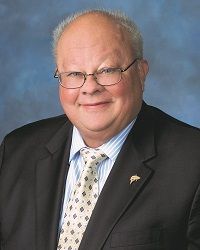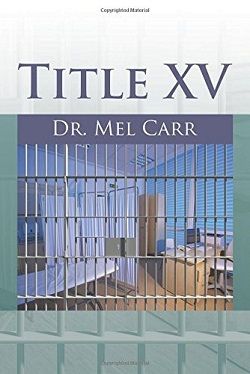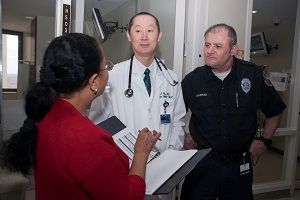Healthcare Behind Bars
Physicians who work in correctional facilities face a range of challenges, from patients with multiple ailments and spotty health histories, to bureaucratic hurdles, and non-compliant patients. However, these doctors also find the work incredibly rewarding, as they see the humanity of their patients in a way most don't.

At year-end 2013, the US state and federal prison population held an estimated 1.57 million inmates, or an increase of 4,300 prisoners over year-end 2012. Those figures from the Justice Department’s Bureau of Justice Statistics are only part of the story.
When factoring in all individuals under adult correctional supervision, which includes those supervised in the community on probation or parole, the year-end 2013 figure stands at 6.89 million.
That’s a lot of people. And they all have at least one thing in common: the need for healthcare services.
“It behooves everybody in corrections to understand that some of these people are very bad, but they are people,” says David Thomas, MD, JD, EdD, professor and chair of the Department of Surgery and Division of Correctional Medicine at Nova Southeastern University’s College of Osteopathic Medicine. “No matter why these people are incarcerated, they are people and they need to be treated like people.”
Magnitude of the Problem
Thomas is well versed in correctional healthcare. As the medical director of Florida’s Zephyrhills Correctional Institute, he has provided full-time, hands-on healthcare services inside a prison facility. It was a job he took because he initially thought it would be an “out of the way, less stressful environment” in which to work. But that wasn’t the case.
“Manipulation and drug-seeking is a much larger problem than in the non-incarcerated world,” says Thomas, assessing life behind prison bars. “In addition, at least 20% of the patients are significantly troubled with a mental disease.”
The disease processes are also more advanced than in the average practice or tertiary care center for 2 reasons. First, those incarcerated usually do not receive even routine medical care until they arrive in prison. And second, their lifestyle before being incarcerated leads them to acquire an epidemiology of diseases different from what is seen in the non-incarcerated world.
“Prisons are repositories of mental health problems, HIV problems, and hepatitis-C problems,” Thompson says. “When these people are not in prison their physical health status means very little to them. Their life is full of other concerns like where their next meal is coming from, or where their next fix is coming from. Healthcare, when they are not incarcerated, is frequently not a high priority for them.”
Thomas explains that having the right mindset, and being educated in the proper mindset, is key to being a good correctional provider. With that in mind, he founded the nation’s first correctional medicine fellowship at NSU. That’s a major milestone, considering the last medical specialty to be established was emergency medicine in 1976.
The fellowship is a 2-year, hands-on clinical didactic program, at the end of which graduates come out with a master of public health degree and a board eligibility or a board certification in correctional medicine which is administered by the American Osteopathic Association. During that fellowship they’re exposed to a gamut of correctional medicine.
“A jail is entirely different than a prison, yet most people lump them all together,” Thompson explains. “Jails are generally short-term facilities with a lot of acute problems. Physicians are trained in the care of intoxication, or care of an acute diabetic episode.”
Prison, on the other hand, is filled with chronic problems. For example, inmates often have significant resistance to many of the drugs for HIV, because they take them while they’re in the incarcerated setting, but once they get out, they may take them once in a while or not at all.
“When they get re-arrested and go back in, you have to figure out a new regimen for them which will work, because they have created resistance to some of the other regimens,” Thompson says. “So, there is a broader scale of knowledge that many physicians must have, and in some areas, it has to be much deeper.”
Thompson explains that, for the most part, inmates are more compliant and very receptive to medical care. But there are exceptions. Some patients will refuse care because that’s the one way they can act out. It’s one of the few things they can control in their life while incarcerated.
“That’s why it makes it a great environment for students and residents because you can see the natural history of a disease,” Thompson says. “Anywhere else, if I treat your diabetes and you don’t like me, you go someplace else, or you don’t go to anybody. In a correctional environment, if you refuse my care for diabetes, I still get to see you back, and I get to see what happens to an untreated diabetic.”

When Mel Carr felt that his medical career as an internist wasn’t advancing, he took a part-time job providing healthcare services to inmates at a correctional facility in southern California. Carr is a pseudonym. The physician was granted anonymity in exchange for speaking with MD Magazine.
As his interest in a private practice continued to decline, his time at the prison was becoming more and more interesting. So when he was offered a full-time position at the correctional facility, he took it.
“I just thought this was going to be another temporary stop, that I wasn’t going to be doing it very long,” Carr recalls. “I was still trying to get something started in the private sector. I wanted to go solo.”
Instead, Carr spent 20 years working at the correctional facility. But his tenure might not have lasted nearly as long had it not been for the influence of Austin Ryder, MD, an older medical colleague at the prison.
“I kind of looked at things on the negative side,” Carr says. “When you work under the correctional department, they don’t want you to do much for the inmates. You’re kind of battling these bureaucracies.”
But Ryder, an African-American, had gone through his share of challenges and prejudices during his career and had developed an optimistic perspective. That perspective rubbed off on Carr.
“We started working together and I began to see things these challenges as an amazing opportunity,” Carr says. “I got organized and started putting together protocols, training doctors, and further educating myself. It was kind of like a new frontier.”
As he explored that frontier Carr encountered many individuals with a dual diagnosis: medical problems and mental health problems. As such, he found himself handling a greater array of conditions than a physician might in a private practice.
“A doctor (in traditional practice) just kind of does his discipline, and then, if there’s some underlying problem, he’s relying on some other doctor to take care of the depression, or the schizophrenia, or bipolar,” Carr explains. “You don’t get that opportunity to deal with the whole patient.”
One key skill Carr developed was compassion.
“You need to be competent, but you have to have compassion,” he says. “And I think you need to have a public health background, too. We had a measles outbreak. There’s a lot of TB, and a lot of sexually transmitted or social disease that you don’t necessarily see in the private setting.”
Today, Carr is back in private practice. What made him leave after 20-plus years? Much of his decision had to do with conflict and internal bureaucracy. He often found himself caught in the middle in battles over whether inmates should remain in the prison when they were ill or should be admitted to a hospital.
“The hospital didn’t want us to put them there,” he says. “We struggled for years to try to get an isolation cell, but couldn’t get it. We struggled for years to get mental health to admit their patients somewhere else, and couldn’t make that happen.”
In addition, Ryder was getting older, and was eventually moved out of his position. Carr immediately clashed with the new physician in charge.
“They were treating me like I was one of the orderlies,” he recalls. “The situation became unbearable. So I did some deep thinking and decided it was time to go. You have to know when it’s your time to leave.”
Carr details his 20-year experience in his book “Title XV”.
“The book is an acknowledgement to those who accepted their situation and continued to provide care to those in need,” he says. “We often mistreat those working in this capacity. But in the end, their commitment to do great work benefits society.”

When Johnny Wu, MD, FACP, CCHP, finished his residency training in internal medicine at Seton Hall in 2001, he joined a large specialty internal medicine/cardiology group in Bridgewater, NJ. There, he had an opportunity to provide general ambulatory service several days a week at the nearby Edna Mahan Correctional Facility for Women.
Today, as director of medical services, fellowship program director, and assistant clinical professor at UConn Health’s correctional managed healthcare unit, he looks back on the experience as enabling him to become a true internist.
“An internist is someone who handles everything, you know, outside of something that needs surgical intervention,” Wu explains. “Nowadays, when people say primary care, they’re looking at family medicine, and sometimes it’s implied you’re not as good because you didn’t go on and get any additional specialized training. But even though I might not have the credential of finishing a board certification of, say, infectious diseases or critical care or gastroenterology, I am able to handle all that stuff, with the exception of having to do procedures.”
That’s important, because working in correctional healthcare, Wu says he has the opportunity to truly be controlling his medical home.
“I trained in Grenada at St. George’s University, so I understand Third World medicine and the British system of training, where the physician takes ownership to try to diagnose, take a very good history, and do a very good physical examination,” he says. “That’s being lost these days.”
Through an agreement with the Department of Corrections in Connecticut, Wu and his staff of 750 full-time and 50 part-time healthcare professionals provide medical, dental, and mental health services to inmates, often right on site. And they see everything from advanced HIV to hepatitis-C to cancer at an early stage.
“In textbooks you say okay, this patient has this one disease, so you just focus on it and treat it,” Wu says. “But we have a patient who has all of these diseases, and they’ve never even seen a physician. They’ve let it go for so long it takes time for us to try and stabilize them.”
Wu has worked closely with the medical staff at John Dempsy Hospital, which is part of UConn Health, to explain and teach about the culture of correctional healthcare. Initially, students began to shadow his staff, and before long nurse practitioners and pharmacy students began rotating through the jails and prisons.
“We approached the American Osteopathic Association about our intent to create a program that would encompass training on all the different aspects of correctional medicine,” Wu says. “Surprisingly, it was approved rather quickly. Now we’re the second accredited program in the country after Nova Southeastern that Dave Thomas put together.”
Wu says that as a clinician working in correctional healthcare, being able to take care of a patient and see their improvement, see the impact that he had, is tremendously rewarding. He often receives letters from appreciative patients stating things like, “You treated me with dignity. You treated me with respect. Nobody else ever treated me like this before.” Some have even contacted him following incarceration and asked if he would be their private physician.
“I don’t practice in the private community,” says Wu, but he acknowledges that the response he receives from patients is a direct result of the trust he has fostered with them.
“Corrections is becoming more like a managed care model,” he says. “It’s certainly HMO, some medical home, and I feel like these are my patients. It’s like back in the day, when doctors were in control of a town.”
